Franky Strachan – 25 May, 2013
As one bends and shifts to observe the varied characteristics of each duo, the display gains a narrative appeal. The distinctively flicked tails, cocked heads, and hunched riders describe the forward thrust of anticipation, exertion and grit. They respond to their respective positions in the race and, while they are gratifying as separate works of art, their presentation as a set depicts the climactic moment of the race with irrefutable vigour.
Milford Gallery currently provides the setting for a frozen race in steel. Nine metal horses, in full-gallop mode, vie for victory as their jockeys spur them on. With each sculpture mounted on its own plinth the viewer is invited to move around them as if they are immersed in a three dimensional rendition of Eadweard Muybridge’s The Horse in Motion (1878).
As one bends and shifts to observe the varied characteristics of each duo, the display gains a narrative appeal. The distinctively flicked tails, cocked heads, and hunched riders describe the forward thrust of anticipation, exertion and grit. They respond to their respective positions in the race and, while they are gratifying as separate works of art, their presentation as a set depicts the climactic moment of the race with irrefutable vigour. (Indeed the term ‘set’ may also allude to the qualities they share with the collectible tin toys you often see in antique stores).
The space is large enough to allow the sculptures their energy for which the walls craftily provide a complementary backdrop. In front of The Race (that is, upon the white wall towards which the horses gallop) there are no artworks. However if you visualize the upshot of this equine spectacle there is room for you to project. Furthermore when standing at the front of the display (looking towards the oncoming mass of racing beasts and jockeys’ whips) your eyes are met with two large horse paintings by Joanna Braithwaite which hang conspicuously in the background. These fairly surreal images of benign-looking horses wearing hats are adorned with badges and pins. They speak of identity and animal-human relationships, having an eerie anthropomorphism and sense of allegory.
Such themes extend the dialogue that The Race initiates. Award-winning artist, Hannah Kidd, has observed the often relaxed nature of New Zealand’s equestrian culture and expressed it using sympathetic materials. This is not to suggest that dressage and formal ritual do not play a part in Aotearoa’s horseback tradition, they of course do, but to say that this particular animal has played an integral role in the country’s history both agriculturally and politically, as well as recreationally.
Furthermore the artist’s exposed welding and extensive use of flattened corrugated iron reflects what I feel is a rustic and rural quality that New Zealand’s mainland holds onto. The last may seem a dated cliché; however upon a recent journey from Dunedin to Akaroa - through towns such as Herbert, Temuka, Hinds, and Chertsey - I witnessed the enduring dominance of the ten-times repaired barn, the rusting tractor, and antiquated signage at full capacity. It is with this in mind, I cannot help but draw a sense of rurality and provincial camaraderie from Kidd‘s sculptures. This is, arguably, an effect of the medium alone - carve the same sculptures in marble, for instance, and one nullifies the bucolic effect of the work.
It is often said that Kidd has a knack for depicting personality, anatomical correctness and all-round appealing subjects, and this holds true for The Race. Horses have been depicted hunting, trotting, galloping, bucking, rearing and running ever since the Stone Age and whether filtered by the mythology of antiquity, the chivalry of the middle ages, the idealism of the renaissance, or the abstractions of cubism, the animal has incessantly permeated visual culture. They are symbolic in many spheres, usually pertaining to power, war, beauty, strength, fertility, or triumph, and they are almost always presented to be admired and respected.
I like it that Kidd does not necessarily ask us to consider any of this. We are asked only to enjoy and relate to the race, both in an immediate sense and more wistfully. The names of the sculptures - National Trevor (2013) or for the plumpish horse in last position: This Little Piggy (2013) - show the artist’s humour, while the open metalsmithing flaunts her skill. There is no need to make comments about the notional standing of equine imagery in the contemporary art world because it would politicise these objects (and their maker) in an unnecessarily weighty manner. Kidd has many species in her repertoire and The Race shows us that horses too, cause her no unease. I would only add that consistency of scale and style in making multiples is not as easy as this artist makes it look.
Franky Strachan
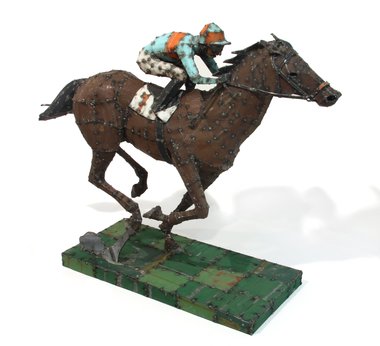
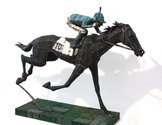
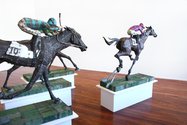

 Two Rooms presents a program of residencies and projects
Two Rooms presents a program of residencies and projects Advertising in this column
Advertising in this column
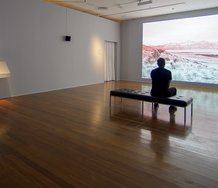
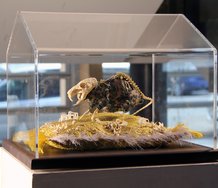
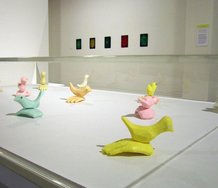
This Discussion has 0 comments.
Comment
Participate
Register to Participate.
Sign in
Sign in to an existing account.